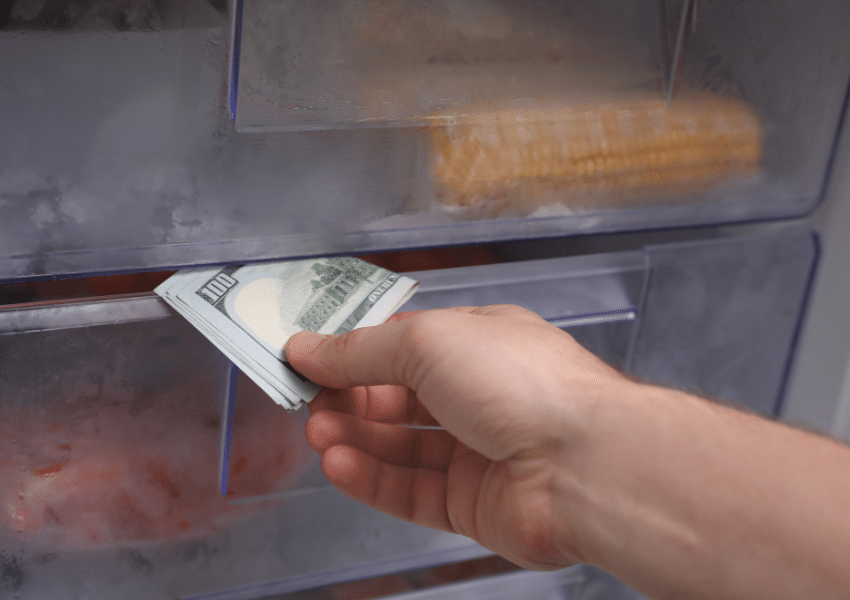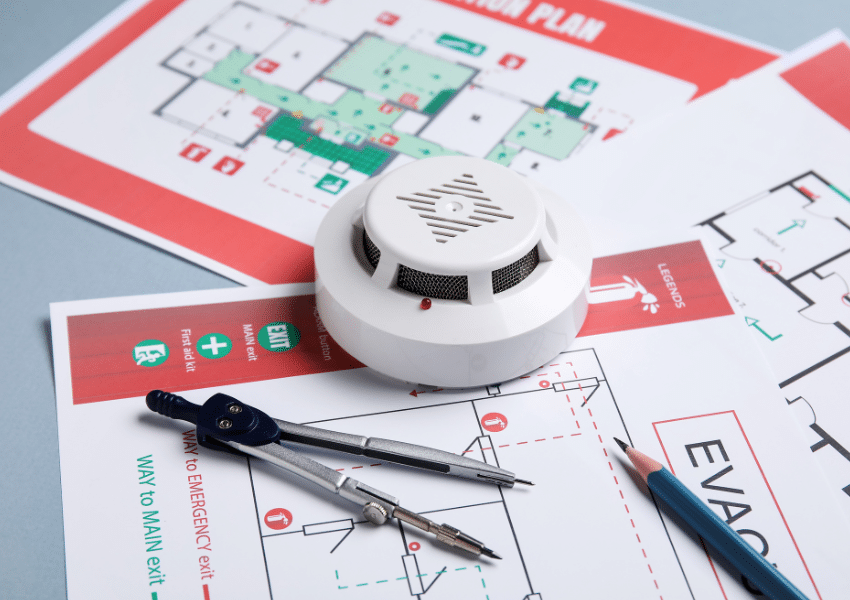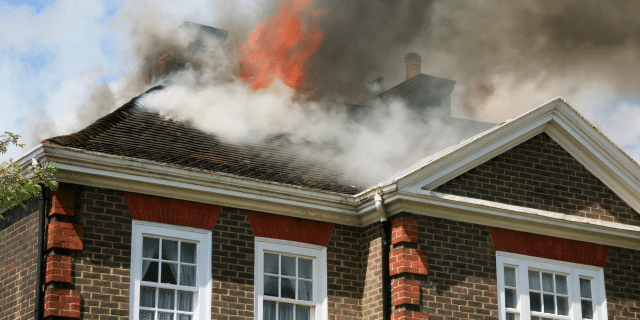
by California Casualty | Helpful Tips, Homeowners Insurance Info |
Think you’ve found the perfect hiding spot for your cash or jewelry? Think again. From the freezer to the sock drawer, burglars know all the “secret” places homeowners use to stash their valuables. Before you tuck away your treasures in plain sight, learn which hiding places offer false security — and where your valuables will truly be safe.
Front Door
We’ve all heard the advice about keeping a spare key “just in case,” but hiding one near your front door is practically an open invitation. The doormat, flowerpot, mailbox, or fake rock –these are the first places a burglar will check. If you need to keep an extra key, leave it with a trusted neighbor instead.
Entryway
Your entry table may be the perfect place for dropping your car keys, wallet, or spare cash when you walk in, but it’s also the first stop for an intruder. Those items are quick to grab and easy to carry. A thief could be in and out of your home in under a minute with your keys, ID, and bank cards in hand.
Bedrooms
Burglars make a beeline for the master bedroom because they know that’s where people store their most valuable items — cash, jewelry, and small electronics. They’ll check dresser drawers, armoires, sock drawers, and even the space under your mattress. Suitcases and storage boxes? Those are fair game, too. The very spots that are most convenient for you are the ones they will check.
Freezer
Think your freezer is foolproof? Think again. Many homeowners wrap cash or jewelry in plastic and tuck it behind the frozen vegetables. But this “clever” hiding place is common knowledge among burglars. If it’s easy for you to access, it’s easy for them to find.
Bathrooms
Your bathroom medicine cabinet may seem like a private place, but it’s often one of the first areas a thief will check — especially if they’re looking for prescription drugs to sell. Don’t keep cash or jewelry there either; it’s too easy to reach.
Cookie Jar
It might seem like a sweet spot to stash your grocery money, but thieves know this classic trick. The same goes for flour tins and coffee canisters. If it’s in plain sight in the kitchen, assume it’s on a burglar’s radar.
Home Office
Your office is a goldmine for identity thieves. Computers, passports, checkbooks, and tax forms can all be used to steal your identity or drain your accounts. Keep sensitive documents locked away and back up important files to a secure cloud account.
Portable Safes
A small safe can keep kids or guests out of your valuables, but it won’t stop a thief from carrying the whole thing out the door. Unless your safe is bolted to the floor or wall, it’s just another box waiting to be picked up and opened later.
Other Bad Spots
Anywhere damp, dirty, or difficult to monitor is also a poor choice. Inside toilet tanks, for example, may seem clever, but the moisture can ruin documents and cash.
Where to Hide Your Valuables Instead
The best hiding places are the ones that require effort to access or don’t make sense for a thief to bother with. Think inconvenient, hidden, or disguised. Here are some ideas.
Trash Can with a False Bottom
A cleverly designed trash can with a hidden compartment can be a surprisingly effective deterrent. Thieves are unlikely to rummage through garbage. Just make sure your valuables are sealed against moisture — and don’t accidentally toss them out on trash day!
Fake Wall Outlets
You can purchase wall outlets that look completely real but pull out to reveal a small hidden compartment. They’re perfect for storing cash, jewelry, or small documents. Just be sure the outlet isn’t connected to any wiring.
Hidden Household Items
Fake food cans or containers designed to mimic ordinary products — like shaving cream or soup — are a discreet way to hide valuables. You can even make your own by hollowing out real cans. Just be careful to make them look authentic, and don’t place them in high-traffic areas where someone might mistake them for the real thing.
Structural Hiding Spots
If you’re handy, consider creating built-in hiding spaces behind removable panels or trim. Hollowed-out wainscoting, door jambs, or floorboards can be excellent concealment spots. Pre-made versions are also available for purchase and can be installed without major renovations.
Books and VHS Cases
A hollowed-out book on a crowded bookshelf — or an old VHS tape in a dusty box — won’t draw a second glance. Just don’t use a book or a tape case you might mistakenly donate.
Storage Bins
Large, unlabeled bins can attract attention, so disguise your valuables among ordinary items. Label bins with dull titles like “Old School Projects,” “Holiday Décor,” or “Winter Clothes.” Even if burglars do open a few, they’re unlikely to dig deep through boxes of tinsel or kids’ art supplies.
Kids’ Bedrooms
While the master bedroom is a prime target, thieves usually skip children’s bedrooms. Consider stashing your valuables in a box on a high shelf in the closet. Further protect it with a misleading label.
Add an Extra Layer of Security
Even the best hiding spots can’t protect your valuables completely. Strengthen your security by:
- Installing a home security system with cameras and alarms to deter burglars.
- Using motion-sensor lighting around entry points to discourage nighttime intrusions.
- Keeping your valuables insured through your homeowner’s or renter’s policy so you’re financially protected even if the worst happens.
By avoiding the most obvious hiding places and thinking creatively about security, you can protect your valuables and your peace of mind.
This article is furnished by California Casualty, providing auto and home insurance to educators, law enforcement officers, firefighters, and nurses. Get a quote at 1.866.704.8614 or www.calcas.com.

by California Casualty | Helpful Tips, Homeowners Insurance Info |
You’ve found the dream apartment — great neighborhood, easy commute, maybe even a dishwasher (score!). But before you start packing boxes, there’s one big question to answer: Can you actually afford it? Figuring out how much rent fits your budget isn’t necessarily exciting, but it can save you from living on instant noodles by mid-month. Let’s break it down.
The Classic 30% Rule: A Starting Point, Not the Whole Story
You’ve probably heard of the 30% rule, the long-standing guideline that says you should spend no more than 30% of your gross monthly income on rent. For instance, if you make $60,000 a year, that’s $5,000 a month before taxes — so 30% would be $1,500 for rent.
Landlords often use a version of this when screening tenants. They look for applicants with an annual income that is at least three times the monthly rent. While this rule can be a useful benchmark, it’s a rough measure. It doesn’t consider student loans, credit card debt, childcare, or savings goals.
In short: the 30% rule is a place to start — but not where your math should end.
Build a Budget That Works for You
Instead of relying on outdated formulas, create a personalized budget that reflects your lifestyle and financial situation. Here’s how.
Step 1: Track Every Expense
To figure out how much you can realistically spend on rent, you first need to know where your money is going. Spend a month tracking your expenses — every dollar. Apps like YNAB (You Need a Budget), or Rocket Money can make this easier by automatically linking to your accounts and categorizing purchases.
Be sure to include:
- Utilities: Gas/electric, water, internet
- Groceries and dining out
- Transportation: Gas, parking, public transit, car payments, vehicle maintenance, and insurance
- Health insurance and out-of-pocket medical expenses
- Debt payments: Student loans, credit cards, personal loans
- Recurring expenses: Subscriptions, memberships, and automated payments
- Entertainment and streaming services
- Gifts, clothes, and home supplies
- Pet expenses
Step 2: Subtract Expenses from Income
Once you’ve totaled your monthly spending, subtract it from your take-home pay (after taxes). What’s left gives you a real idea of what you can afford for rent.
If that number feels tight, look for easy trims. Could you cut back on takeout or unused subscriptions? Maybe refinance student loans or car payments for lower rates. Don’t go overboard — budget changes that are too drastic rarely stick — but even small shifts can free up hundreds a month. Consider a roommate if that’s an option.
The 50/30/20 Rule: A Smarter Spending Framework
If you like structure but want more flexibility than the 30% rule, try the 50/30/20 budget. It divides your income into three simple categories:
- 50% for needs: Rent, utilities, groceries, transportation, insurance, and other essentials
- 30% for wants: Dining out, clothing, hobbies, travel, and entertainment
- 20% for savings and debt: Emergency fund, retirement contributions, or extra payments toward loans
This framework gives you room to breathe while keeping savings front and center. And if your “needs” category (including rent) creeps higher than 50%, that’s your signal to re-evaluate what you can comfortably afford.
Plan for the Unexpected
Even the best budgets can be derailed by surprise expenses — car repairs, medical bills, or job changes. That’s why it’s smart to build an emergency fund.
Financial experts recommend setting aside enough to cover three to six months of expenses. That might sound like a lot, but you can start small. Even putting away $50–$100 a month adds up over time — and gives you peace of mind knowing you’re protected if something unexpected happens.
Beware of Rental Scams
In today’s tight housing market, scammers are getting more creative — and more convincing. If a listing feels off, trust your gut. Here are some red flags that could indicate a fake rental ad:
- The deal seems too good to be true (it probably is).
- There’s no physical address
- Communication happens only through email or text — no phone calls or in-person meetings.
- The “landlord” seems too eager to rent and skips background checks.
- You’re asked to wire money or send a deposit before seeing the property.
- There’s no lease or you’re told one isn’t necessary.
- The landlord claims to be “out of town” but will hold the unit for you once you send money.
Always visit the property in person, verify the owner’s identity, and never send payment until you’ve signed a legitimate lease.
Don’t Skip Renter’s Insurance
Once you’ve signed the lease and unpacked your boxes, there’s one more thing you’ll want to check off your list: renter’s insurance. Starting at around $10 a month, renter’s insurance is one of the most affordable ways to protect yourself financially. Your landlord’s insurance only covers the building — not your personal belongings.
Renter’s insurance typically includes:
- Personal Property Coverage – Protects your belongings from theft, fire, or other covered losses.
- Liability Coverage – Helps pay for damages or injuries if you’re found responsible.
- Additional Living Expenses – Covers hotel or temporary housing costs if your apartment becomes uninhabitable.
Think of it as a safety net for the unexpected. And if you bundle your renter’s policy with an auto policy through California Casualty, you may qualify for premium discounts — a smart way to save even more each month.
Finding the perfect apartment should be exciting, not stressful. By taking the time to crunch the numbers, track your spending, and plan ahead, you can move into your new place with confidence (and still have money left over for furniture or Friday night pizza).
This article is furnished by California Casualty, providing auto and home insurance to educators, law enforcement officers, firefighters, and nurses. Get a quote at 1.866.704.8614 or www.calcas.com.

by California Casualty | Helpful Tips, Homeowners Insurance Info, Safety |
When fire breaks out, every second counts. Knowing exactly what to do—and what to avoid—can mean the difference between safety and tragedy. Whether you’re at home, at work, or out in public, understanding how to respond in a fire emergency gives you the power to act quickly, protect loved ones, and make it out safely.
Understanding the Phases of a Fire
Before you can respond effectively, it helps to understand how a fire behaves. Fires move through distinct phases, though the timing can vary depending on what is burning and where the fire occurs:
- Incipient Phase – This is the very beginning, when the fire first ignites. If detected quickly, it may still be possible to put it out safely with the right tools.
- Growth Phase – Flames spread, heat builds rapidly, and conditions begin to change. This is when a small fire can suddenly get out of control.
- Fully Developed Phase – At its peak intensity, a fire consumes all available fuel, producing thick smoke and toxic gases. Escape is the only safe option.
- Decay Phase – As the fire runs out of fuel, flames and heat decrease, but smoke and gases can still be dangerous.
What to Do in a Fire Emergency
When you encounter fire, your actions need to be quick, calm, and deliberate. Here are the key “Do’s” to remember:
1. Act Early if It’s Safe
If you catch the fire in its earliest stage (the incipient phase), and you have the right type of extinguisher, you may be able to stop it from spreading. Always aim the extinguisher at the base of the flames, not the middle or top.
In the kitchen:
- Turn off the heat source.
- Smother small stovetop flames with a metal lid, baking sheet, or fire blanket.
- Use baking soda or salt on grease fires—but never water or flour.
- Follow these tips for other ways to put out a fire.
- If a fire starts inside your oven or microwave, keep the door closed. The lack of oxygen will usually cause the fire to die down.
If the fire is spreading quickly, do not try to fight it. Get out immediately and call 911.
2. Get to Safety
Plan for at least two exits from every room in your home. Fires often make the most obvious path unusable. Heavy smoke can quickly disorient you, so it helps to know the layout of your home by memory. Practice fire drills with your family so that everyone knows how to react without hesitation.
3. Stay Low
Smoke rises and carries carbon monoxide, which can make you dizzy or even cause unconsciousness. Crawling low to the ground gives you cleaner air to breathe and increases your chance of escape.
4. Stop, Drop, and Roll
If your clothing catches fire, don’t run. Running only fuels the flames. Instead, stop, drop to the ground, and roll back and forth while covering your face. This smothers the flames and helps prevent serious injury.
5. If You’re Trapped
Sometimes escape isn’t possible. If you can’t get out:
- Stay away from doors that are hot to the touch.
- Block smoke by placing wet towels or blankets along the bottom of doors.
- Open windows cautiously, crouching down to avoid rising smoke and heat.
- Signal for help by waving a flashlight or cloth out the window.
What NOT to Do in a Fire Emergency
Just as important as knowing what to do is knowing what not to do. Certain instinctive reactions can actually make things worse:
- Don’t use elevators. Fires can cause electrical failures or trap you inside. Always use the stairs.
- Don’t pour water on grease fires. Water splashes burning oil and creates explosive steam.
- Don’t pour flour on a fire. Flour is combustible. Stick with baking soda, salt, or a fire extinguisher.
- Don’t use water on electrical fires. Water conducts electricity and can cause electrocution.
- Don’t fan flames. Adding oxygen only makes a fire grow.
- Don’t stand too close or reach over flames. Loose clothing can ignite quickly.
- Don’t move burning objects. This can spread flames to new areas.
- Don’t aim a fire extinguisher at the flames themselves. Remember: always target the base of the fire.
Preparing Before a Fire Happens
While these tips can help in the moment, preparation is your best defense. Here’s how to protect yourself and your loved ones:
- Install smoke alarms on every level of your home, especially near bedrooms. Test smoke detectors monthly and replace batteries at least once a year.
- Create and practice a fire escape plan with your household. Make sure every member—children included—knows how to get out and where to meet once outside.
- Keep fire extinguishers accessible. Place them in the kitchen, garage, and near exits. Learn how to use them before an emergency arises.
- Understand the common causes of fires so you can take steps to fireproof your home and minimize these risks.
- Know your insurance coverage. Even when you do everything right, fires happen. Having the right coverage can make the recovery process easier and less stressful.
This article is furnished by California Casualty, providing auto and home insurance to educators, law enforcement officers, firefighters, and nurses. Get a quote at 1.866.704.8614 or www.calcas.com.

by California Casualty | Helpful Tips, Homeowners Insurance Info |
That picture-perfect porch or freshly painted shutters might catch your eye but looks aren’t everything when it comes to house hunting. The smartest buyers dig deeper, considering how a home’s layout will work day-to-day, the strength of the neighborhood, and how well the property will hold its value over time. After all, the best home isn’t just the one that charms you at first glance—it’s the one that pays off in the long run.
Here are some key things to look for beyond curb appeal when you’re searching for your next home.
Natural Light
A bright, airy space feels welcoming—and it can save you money on utilities by cutting down the need for artificial lighting. As you walk through a potential home, notice the direction of the windows and how the sunlight filters into each room. Morning light may make a kitchen cheerful, while evening sun could make a family room glow. Don’t just admire the view—test the windows. If they stick or are difficult to open, it might indicate foundation or insulation issues. Outdated windows may also need replacing, which can be a costly project.
Storage Space
It’s easy to fall in love with a home during a tour, only to realize later that there’s nowhere to put your holiday decorations, sports equipment, or bulk groceries. Storage goes beyond closets—think attic, basement, garage, pantry, and even built-in cabinetry. Ask yourself whether the available storage fits not only your current lifestyle but also your future needs. After all, homes have a way of filling up quickly.
Layout and Flow
The layout of a home impacts your daily routine more than you might realize. Picture yourself moving through the space: is the kitchen conveniently located near the dining area? Is there room to entertain friends, host family gatherings, or create a home office if you need one? Pay attention to how the rooms connect. An awkward floor plan can make everyday life feel more complicated, while a well-designed layout adds comfort and efficiency.
Noise Levels
Silence is golden—or at least, peace and quiet can be. While touring, pause and simply listen. Do you hear traffic, barking dogs, or nearby train whistles? Inside, thin walls may let in sound from neighbors or other parts of the house. For a more complete picture, ask future neighbors about noise at different times of day. What’s peaceful during an afternoon showing might sound very different on a Saturday night.
Odors and Air Quality
Your nose knows. Strong odors can signal deeper problems, like water damage, frequently flood basements, mildew, or smoke. Musty smells might point to leaks or poor ventilation, while pet accidents or cigarette smoke can be stubborn to remove. Air quality is not only a comfort issue—it’s a health consideration. If something smells off, take it seriously and investigate further.
Functionality and Condition
Think about whether the home is move-in ready or if you’ll need to tackle renovations before unpacking boxes. Check appliances to ensure they’re in working order. Test faucets, light switches, and outlets. Little things add up, and repairs can quickly turn a “dream home” into a financial drain if you’re not prepared.
Foundation and Structural Issues
A beautiful exterior can hide serious problems. Look for cracks in the basement walls or around the outside of the home. Uneven floors, sticking doors, or gaps in window frames can also be red flags. While not every crack is cause for alarm, structural concerns are best evaluated by a professional inspector before you make an offer.
Features and Maintenance
Extra features can be both a blessing and a burden. A spacious lawn may look like the perfect play area, but it will need regular mowing and landscaping. A pool can be fun in the summer, but it comes with ongoing maintenance, insurance considerations, and added liability. Consider carefully which features enhance your lifestyle and which may turn into costly chores.
School District
Even if you don’t have children, the quality of the local schools impacts property values. Homes in sought-after school districts tend to hold value better and sell more quickly. If kids are in your present—or your future—it’s an even more critical factor. Research test scores, extracurricular offerings, and community reputation to make an informed decision.
Long-Term Value
Buying a home is one of the largest investments you’ll make, so think long term. Look for homes in neighborhoods where property values are trending upward. A smart rule of thumb: buy the lowest-priced home in the best neighborhood you can afford. Over time, that decision could pay off with significant equity growth.
Budget and Affordability
Before you fall for any home, take a hard look at your budget. Factor in more than just the down payment and monthly mortgage. Closing costs, utilities, property taxes, home insurance, and future repairs all add to the bottom line. Don’t forget the cost of a professional inspection—it’s money well spent to avoid surprises later. Getting pre-approved for a mortgage helps you know exactly what you can afford, and protecting your investment with the right insurance ensures peace of mind.
The Bottom Line
Curb appeal matters—it’s often what draws you to a home in the first place. But the smartest house hunters know to dig deeper. Natural light, storage, layout, functionality, neighborhood trends, and long-term value all play a part in making a home the right fit. By asking the right questions and looking beyond the surface, you’ll set yourself up not only for a smooth move-in but also for a smart financial future.
This article is furnished by California Casualty, providing auto and home insurance to educators, law enforcement officers, firefighters, and nurses. Get a quote at 1.866.704.8614 or www.calcas.com.

by California Casualty | Helpful Tips, Homeowners Insurance Info |
It only takes a moment—a forgotten candle, an overloaded outlet, a stray spark from the stove—for a cozy home to turn into a dangerous blaze. Every year, thousands of families face the devastating aftermath of house fires, many of which could have been prevented. Understanding the most common causes of home fires isn’t just smart—it’s essential. Here’s what you need to know to keep your loved ones safe and your home protected.
Cooking
A leading cause of house fires, unattended cooking is one of the biggest risks in the kitchen. Cooking fires can ignite in seconds, and flammable items like towels or food packaging can easily catch fire if placed too close to a hot burner.
How to prevent:
- Stay in the kitchen. Never leave food unattended when frying, grilling, or broiling. If you must leave, turn off the stove or oven.
- Use timers. Set a timer as a reminder that something is cooking, especially for longer tasks like baking or simmering.
- Clear the area. Keep oven mitts, paper towels, curtains, and wooden utensils away from burners.
- Turn pot handles inward. Prevent accidents by keeping handles turned toward the back of the stove.
- Avoid distractions. Don’t cook if you’re feeling drowsy or have consumed alcohol or sedating medications.
Heating
As temperatures drop, heating equipment becomes a top source of home fires. Space heaters, fireplaces, and wood-burning stoves can all spark danger if not used carefully.
How to prevent:
- Keep a safe distance. Maintain at least 3 feet of space between heaters and anything flammable—furniture, curtains, bedding, etc.
- Upgrade old equipment. Choose space heaters that turn off automatically when overheated or tipped over.
- Maintain chimneys and furnaces. Have them professionally inspected and cleaned annually.
- Dispose of fireplace ashes properly. Let ashes cool completely and place them in a metal container with a lid. Place them outside and away from your home.
- Use fire screens. Always use a sturdy screen or glass door in front of fireplaces.
Electrical
Modern homes rely on more electronics than ever—but faulty wiring or improper use of power and extension cords can lead to disaster.
How to prevent:
- Don’t overload outlets. Avoid using multi-plug adapters or plugging too many devices into one outlet.
- Inspect cords. Replace frayed, cracked, or damaged cords immediately.
- Pay attention to wattage. Always use light bulbs that match the fixture’s recommended wattage.
- Look for warning signs. Flickering lights, discolored outlets, burning smells, or frequent blown fuses are red flags.
- Upgrade protection. Install Arc Fault Circuit Interrupters (AFCIs) and surge protectors. Consider smart sensors that alert you to abnormal power use or overheating.
- Call an electrician. Have a licensed professional inspect your system if you suspect any issues.
Candles
While they add ambiance, candles can also add risk. An open flame left unattended is a leading cause of home fires.
How to prevent:
- Never leave a candle burning unattended. Always extinguish it when you leave the room or go to sleep.
- Watch placement. Keep candles at least 12 inches away from anything flammable—curtains, books, decorations.
- Use sturdy holders. Place candles on heat-resistant surfaces and avoid wobbly furniture.
- Keep away from pets and children. Curious hands and wagging tails can easily knock over a candle.
- Don’t burn to the bottom. Leave at least a half inch of wax in the container to prevent overheating and cracking.
Dryer Vents
Dryers are a common cause of home fires, and too often, the lint traps are the culprit. Making sure your lint trap is not too full will help.
How to prevent:
- Clean the lint filter after every load. Remove lint from around the dryer rim.
- Check the vent hose regularly. Make sure it’s not kinked or clogged. Make sure the outdoor vent flap opens when the dryer is on.
- Move flammable items. Move cardboard and cleaning supplies away from the dryer, especially when it is on.
Smoking
Careless smoking is another major contributor to home fires—especially when done indoors or near flammable materials.
How to prevent:
- Never smoke in bed or when drowsy. It makes it too tempting to skip safe disposal and it’s too easy to fall asleep.
- Use deep, sturdy ashtrays. Ensure cigarette butts are completely extinguished.
- Don’t toss butts in the trash. Dispose of them in a metal container or douse with water before discarding.
Preventing a fire doesn’t stop with avoiding hazards—it includes being prepared in case one does occur.
- Install smoke detectors. Place them on every level of your home, inside bedrooms, and outside sleeping areas. Test them monthly and change the batteries twice a year (when you change the clocks).
- Have an extinguisher on hand. Keep one in the kitchen and know how to use it. Check that it’s not expired.
- Keep flammable items out of reach. Store matches, lighters, and chemicals where children can’t access them.
- Follow these tips to fireproof your home. There’s a lot that you can do inside and outside.
- Create a fire escape plan. Practice it with your family so everyone knows how to exit quickly and safely.
Your home is one of your greatest investments. Make sure it is fully protected with the right insurance.
This article is furnished by California Casualty, providing auto and home insurance to educators, law enforcement officers, firefighters, and nurses. Get a quote at 1.866.704.8614 or www.calcas.com.

by California Casualty | Helpful Tips, Homeowners Insurance Info |
Ready to roll up your sleeves and boost your home’s value without breaking the bank? Whether you’re prepping to sell or just want to make your space shine, the right DIY projects can deliver big returns—and serious satisfaction. From weekend upgrades to clever curb appeal tricks, we’re diving into easy, affordable ways to make your home more appealing to buyers and more enjoyable for you. Let’s get started—toolbox optional, enthusiasm required!
Freshen Up with Paint and Wallpaper
Paint is one of the most cost-effective ways to transform your home. And it doesn’t stop at the walls! Try painting your kitchen island a bold color or adding contrast by painting trim, molding, or millwork. Pair soft white walls with a neutral island and colorful trim to let the details shine.
Give your front door a splash of color to boost curb appeal instantly. Or refresh dated kitchen cabinets with a coat of paint or stain. Peel-and-stick wallpaper is a great way to add personality with minimal effort—try it on an accent wall or even as a unique backsplash.
Upgrade Fixtures for a Stylish Finish
Swapping out outdated fixtures can give your home a modern edge—and lighting especially can make a difference. Start with the bathroom: replace an old faucet and old vanity lighting with something more stylish.
In the kitchen, replace your faucet. Convert recessed lights to pendant lights for an instant design upgrade—hardware store kits make it easy. Throughout your home, switch out builder-grade light fixtures for ones that reflect your personal style, and don’t overlook the details: new metal switch plates can add a surprising dose of polish.
Add Charm with Décor Details
Sometimes it’s the little touches that make the biggest impact. Display beautiful cookware on brass racks to elevate your kitchen’s look and free up cabinet space. Swap out cabinet hardware for on-trend pulls—just be sure to match existing holes for easy installation (tip: bring an old one with you when you shop!).
Hang curtains using tension rods and clip-on rings for a no-drill window treatment. Brighten glass-front cabinets with colorful self-adhesive shelf liners. Mirrors placed strategically can make rooms feel larger and filled with natural light.
Refresh Furnishings and Layouts
Furniture can work double-duty when it’s thoughtfully chosen. Consider recovering worn chairs or swapping out bar stools for a more modern look. Create a cozy breakfast nook with a slim table, a few chairs, and a bench—bonus points if it includes hidden storage.
Speaking of storage, look for pieces that offer built-in compartments or shelves to reduce clutter. Want to add buyer appeal? Carve out a home office space. Even a walk-in closet or pantry can be transformed into a compact yet functional workspace.
Enhance Floors Underfoot
Flooring can make or break a first impression. If you have hardwood, refinishing it can dramatically boost your home’s value. Want a simpler update? Add a carpet runner in the entryway or kitchen to define the space and add comfort where you stand most.
Bathroom flooring is a great place to try a DIY upgrade—it’s typically a smaller area and a neutral finish goes a long way in appealing to future buyers.
First impressions matter, and your home’s exterior sets the tone. A good power wash can do wonders—and if that’s not enough, consider painting the siding, trim, or shutters for a clean, fresh look. Don’t forget the gutters—cleaning them is a small job that makes a big difference.
Tidy up your landscaping by trimming overgrowth and patching bald spots in the lawn. Add perennials along walkways or in front of the house for low-maintenance greenery that returns year after year. If you have pets, make sure it’s pet-friendly. Repair and refresh your deck to keep it looking its best. Declutter your garage and consider some easy garage updates.
Want a quick style boost? Update your mailbox or address numbers for a simple but noticeable refresh.
Considering bigger home renovations? See our blogs on DIY versus going pro and how to avoid contractor scams.
Your home is likely one of your greatest investments—protect it and help it shine with projects that add value and personality. And don’t forget, the right insurance coverage is just as important.
This article is furnished by California Casualty, providing auto and home insurance to educators, law enforcement officers, firefighters, and nurses. Get a quote at 1.866.704.8614 or www.calcas.com.






